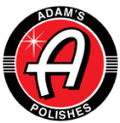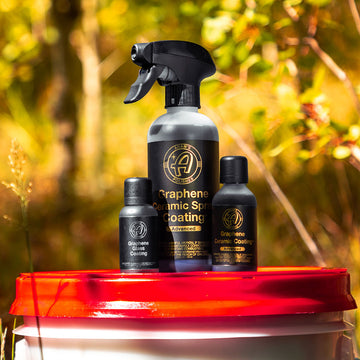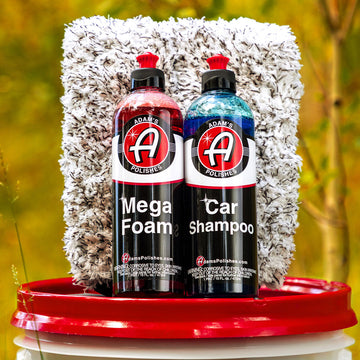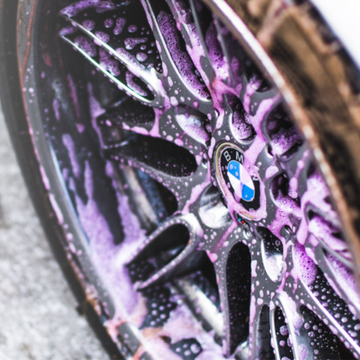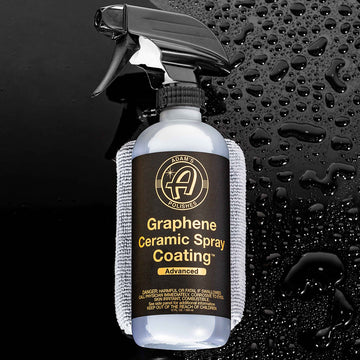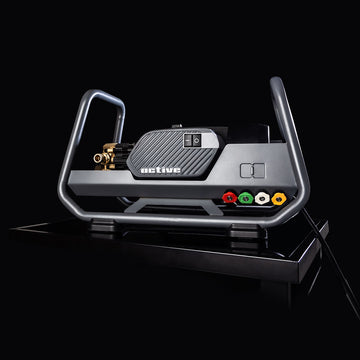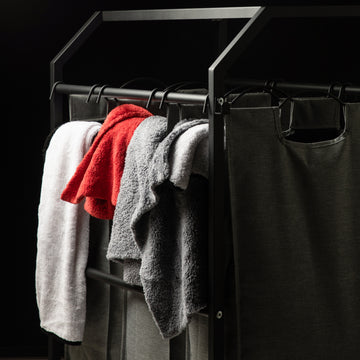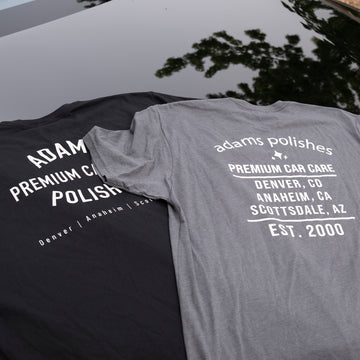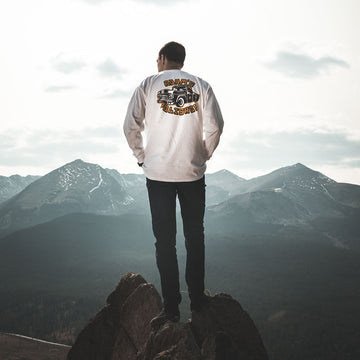Waterless Wash. Many of you may have heard this term, and some may not be familiar with it. Waterless Wash is exactly what the name implies - a method to clean the exterior of your vehicle without the use of a water source. You might be skeptical, or wonder how you can safely wash your ride without the traditional soap, water, Grit Guard or Dirt Lock, bucket, wash pad, and a hose/pressure washer; however, with the right products and technique, waterless washing is a very viable option for many scenarios. In this write-up, we’ll explain exactly “What is Waterless Wash?”, dispel any misconceptions about the technology, cover its use cases and limitations, and compare it to some of our most common spray-and-wipe products in our lineup.
Adam’s Waterless Wash is eco-friendly, and one of its main uses when being developed was to serve as an effective cleaning solution for areas with water restrictions, where you may not be permitted to use soap and water to wash your vehicle. Since there is no water involved, and the chemical is absorbed into microfiber towels, there is no worry about any chemical run-off into drainage systems, lawns, and so on. This makes Waterless Wash a perfect option for those living in an apartment complex or water-restriction areas that may not permit traditional car washing. Collector cars are another excellent use for Waterless Wash. On older and vintage vehicles, many owners do not want to use a hose and water on them, to prevent rust inside of body panels where drain channels may be clogged from decades of use. In fact, Waterless Wash is how our team safely cleans over 1,000 auction vehicles every year at the four Barrett-Jackson Collector Car Auctions around the country!
Waterless Washing
In Depth
Introduction
How Does It Work?
Waterless Wash is a very easy-to-use product, but it’s actually one of our most complicated chemicals, with the highest number of components to its formula out of every chemical that we offer! As you spray Waterless Wash onto a vehicle surface, it uses special lubricating agents to help loosen and lift dirt in much the same way that our soaps loosen dirt from a surface - just without the foam and soap suds that must be rinsed off. Whether you are cleaning paint, glass, chrome, or wheels, Waterless Wash is suitable for all of these surfaces. It is safe for use on exterior plastic and rubber trim surfaces as well, such as running boards, wiper cowls, side mirrors, window trim and even engine bay plastics. Once wiped away with a waffle-weave Waterless Wash Towel, it will not leave any color enhancement or slippery feeling to these pieces like can occur with dressings.
Many wonder how Waterless Wash can remove light dirt without scratching the vehicle, since you are not doing an initial rinse with a strong stream from a garden hose or pressure washer. Using one towel to pull away dirt and absorb the majority of the liquid, followed by a second dry towel to leave a streak-free finish are the main keys to using Waterless Wash properly. There are instances where a vehicle is too dirty to safely use Waterless Wash for cleaning, and we will cover those cases in a later section of this write-up. Along with the slickness and lubrication of the formula, the technique and towels used are equally as important. You will want to clean one area or panel at a time, and you do need to saturate the area generously in order to be as safe as possible. We recommend cleaning from the top-down, noting the lower and rear parts of the vehicle will usually have the heaviest amount of dirt and debris, but as long as you keep using new clean sections of a towel or grabbing a fresh towel, you can clean body panels in your preferred order. Now let’s move onto a quick discussion of the towels themselves.
Waterless Wash Waffle Weave Towel
Our Waterless Wash Towels are very unlike our traditional plush polishing microfiber towels. They are a much thinner microfiber material that utilizes a waffle-weave pattern, or a grid of small square channels, to encapsulate dirt. Using very light pressure, you will slowly wipe the Waterless Wash Towel over the saturated area in a smooth, sweeping motion, in one direction. We do not recommend circular motions - if the towel does end up picking up a larger piece of grit or sediment, a circular motion could put far more difficult to remove scratches into the surface before you notice it, rather than just having one horizontal or vertical scratch to polish out. The waffle pattern will pull the dirt up into the small channels of the towel as it absorbs the majority of the chemical, so that the dirt particles have less chance of continuing to drag on the surface. Folding the towel into smaller rectangles will give you multiple cleaning surfaces for each towel before you will need to set it aside and wash it - we’ll explain our recommended folding size in the Process section up next.
When Can I Use It And On What Surfaces?
One question we receive very often is “How dirty is too dirty to use Waterless Wash?” A general rule of thumb is that if there is a heavy amount of dirt, salt, or ash buildup or mud caked up on the vehicle, then you will not want to immediately use Waterless Wash. In these instances, especially during winter months when it might be too cold to wash your vehicle in your driveway, it would be best to use a pressure washer at home or at a pay-and-spray car wash to remove the majority of heavy debris and mud first. Then you can proceed to use Waterless Wash with several Waterless Wash Towels to clean the remainder of the vehicle. For light to moderate dirt or sediment, for example if your vehicle is clean and then you are caught in a rainstorm driving home, Waterless Wash is an effective way to make your vehicle look great again with little time and effort. Waterless Wash can also be used as often as you would like, without fear of any buildup on the surface. It is safe to use on clear coat, lacquer, and single stage paints, matte, satin and glossy vinyl wraps, stripes, and stickers, as well as paint protection film (PPF). Our Waterless Wash is safe for use over waxes and sealants, and our ceramic or Graphene Ceramic coating options.
One of the most common uses of Waterless Wash is for dust removal. Your vehicle can build up light dust from sitting in the garage, driving to a Cars And Coffee event, or even parked at a cruise-in or car show, and Waterless Wash is a preferred method to keep it looking its best. Duster wands push dust around on the surface and keep all of the dirt particles at the end of the fibers of the duster, which ends up working like thousands of tiny fingers holding dirt and dragging them across the surface. This is a great way to cause a large amount of long faint scratches and swirl marks in the clear coat that would then require machine polishing to fix, which we cover in another write-up, Machine Polishing 101. Using Waterless Wash to keep the surface slick while wiping away dust with a clean, folded Waterless Wash Towel has much less potential for causing any faint scratches in the paint of your vehicle.
The Process
While Waterless Washing is a simple process, you still want to prepare everything you will need before you start to clean the vehicle. We recommend having a full 16oz bottle of Waterless Wash, though you may only use half of a bottle or less, depending on the size of the vehicle and the level of dirt on it. The Adam’s iK Multi Pro 2 pressurized sprayer is also an excellent choice to use with Waterless Wash if you are cleaning a large vehicle like a camper or trailer, or multiple vehicles in one session. It’s great for mobile detailers since it doesn’t take up much space, saves your fingers from cramping up from pulling the trigger so much, and holds 42oz of usable liquid.
You will need multiple clean waffle-weave Waterless Wash Towels as well. We recommend at least 4 towels for a midsize sedan - 3 towels for doing the initial cleaning wipe, and 1 dry towel to follow behind and remove the remaining residue. For larger trucks and suvs, we recommend a 6-pack of Waterless Wash Towels. Fold the towel in half twice to have 8 working “sides” per towel, or fold it over 3 times to have 12 smaller “sides” per towel. Once a “side” becomes saturated and dirty, flip the towel over to a new clean side and continue on. This way you are not reintroducing dirt and grit back onto the vehicle as you clean the next section or panel. Once all sides of a towel are soiled, set it aside - preferably in a 5-gallon bucket to soak in a mixture of warm water and an ounce of Towel & Pad Revitalizer. Below is the step-by-step process for cleaning a vehicle with Waterless Wash and the corresponding waffle-weave Waterless Wash Towels.
Pro-Tip: For large campers and trailers, you may find that using a few Ultra Plush Drying Towels instead of Waterless Wash Towels will cover more surface area faster.
Waterless Wash Step by Step:
- Prepare your materials - Waterless Wash spray bottle, 4 or more Waterless Wash Towels, and a bucket to set soiled towels in once they have been used.
- Inspect the vehicle for large dirt particles or heavy grit. Do not use Waterless Wash for extremely dirty or muddy finishes. If heavy mud is present, pressure wash off as much as possible before using Waterless Wash.
- Spray Waterless Wash generously onto the area or panel to be cleaned.
- Take one waffle-weave Waterless Wash Towel and fold into eighths, to have a cleaning surface measuring roughly 6in x 8in.
- Begin to wipe the area with light pressure. Starting with the top of a panel, work downward by gliding the towel over the area in left/right or up/down movements and working your way down the panel to finish. Do not wipe in circular motions.
- As one side of the towel becomes soiled and saturated, flip, fold, or rotate the towel to a fresh side and continue wiping the surface. Waterless Wash residue will remain on the surface as dirt is pulled into the towel.
- Use a second, clean and dry Waterless Wash Towel to wipe away the remaining residue on the panel for a streak-free finish.
- Continue onto the next area of the vehicle, by spraying the panel first, then wiping with the damp towel to remove dirt, and following up with the dry towel to leave a perfect finish.
- After all sides of the damp towel have been saturated with dirt, place the dirty towel in the bucket, use your second drying towel as your new dirt removal towel, and then grab a fresh clean Waterless Wash Towel to use as your new drying towel.
- Spray and wipe lower sections of the vehicle last - bumpers, the lower half of doors, rocker panels, exhaust tips, inner fender lips, and wheels. These areas will typically have the heaviest amount of dirt.
Product Comparison
Some other very common questions we are asked are “What’s the difference between Detail Spray and Waterless Wash?”, “Which is better - Waterless Wash or CS3?”, and “Can I use Waterless Wash and then Slick & Slide?” These are all valid questions, and it can become confusing at times with the multiple spray-and-wipe products that we offer. We’ll provide a quick overview of each, and explain their similarities and differences, so that you are confident in making the right choice for your specific vehicles and needs.
Waterless Wash is a straight cleaning product. It offers no protection or shine enhancement, and simply just cleans a surface safely and effectively. Detail Spray is better suited to be used on an already clean surface, so it can be used after Waterless Wash to add a little more pop and shine to the finish and give a slight bump in protection. Detail Spray can be used to remove light dust, but it is not recommended to be used to remove dirt. Our Detail Spray does not contain wax, but it does have special polymers for gloss. It is safe for use over waxes, sealants, and ceramic coatings; however there are more ideal products to use on coated vehicles, which we cover in our ceramic coating write-ups. Next up is Matte Detailer. Adam’s Matte Detailer has a very similar function to Detail Spray, with the main difference being that it does not add any shine. Therefore, as the name implies, Matte Detailer is intended for use on matte surfaces, such as matte paint finishes, satin or matte vinyl wraps and stripes, and matte carbon fiber. Matte Detailer will leave a nice, even appearance to matte surfaces, and has a streak-free, zero shine look when wiped away properly.
We then move onto an all-in-one product, Adam’s CS3. CS3 stands for Clean, Shine, and Protect - it has the cleaning power of Waterless Wash, the shine enhancing properties of Detail Spray, and the protection and hydrophobic behavior of silica-infused products. CS3 quickly became a favorite of many customers after we introduced it. You use it in the same manner as Waterless Wash, but you may find that you need to wipe it away more quickly and more thoroughly to avoid possible streaks and smears, especially on darker colored vehicles or if you are using it in hot temperatures or in direct sunlight. This is due to the silica properties of the formula requiring a bit more effort to wipe away. If any streaks do occur, using a Single Soft or Borderless Grey Towel with one very quick mist and wipe of CS3 over the affected area will usually eliminate the streaks easily.
We’ll finish out the comparison with our Slick & Slide and finally Graphene CS3. Slick & Slide can be viewed as an enhanced version of our normal Detail Spray. Adam’s Slick & Slide has a cross-linking polymer formula, which means that it makes the surface even more slippery and smooth, but just like Detail Spray, it is intended to be used on an already clean surface. When you arrive at a car show for example, you could clean the surface with Waterless Wash first, and then add some incredible shine with Slick & Slide before the judges come around. Lastly, Graphene CS3 is an updated version of CS3, with reduced graphene oxide added into the formula to pair well with a vehicle coated in one of our Graphene Ceramic Coating options. It cleans, shines, and protects in one go, and does require more thorough wiping of areas with your second towel, just like CS3. Below is a comparison chart that summarizes each of the products discussed in this section of the write-up.
| Product | Cleans Dirt? | Shine Enhancement? | Adds Protection? | Protection Family |
|
Waterless Wash |
Yes |
No |
No |
N/A |
|
Detail Spray |
No |
Yes |
Minimal |
Polymer |
|
Matte Detailer |
No |
No |
No |
N/A |
|
CS3 |
Yes |
Yes |
Yes |
Ceramic |
|
Slick & Slide |
No |
Yes |
Yes |
Polymer |
|
Graphene CS3 |
Yes |
Yes |
Yes |
Graphene |
Other Uses
Besides cleaning your vehicle, Waterless Wash can be used in a few other ways that are certainly worth mentioning in this blog.
Drying Aid
Waterless Wash can also be used as a drying aid, if you simply want to assist with removing any streaking or water spots without adding any protection in the process. After you have done a traditional Two Bucket Wash and rinse, you can lightly mist Waterless Wash around the vehicle in much the same way you would use Detail Spray as a drying aid, then dry with your Ultra Plush or Jumbo Plush Drying Towel. Hitting a few key drip areas with Waterless Wash and a blue Waffle Weave Waterless Wash Towel is a great follow-up after you finish drying the majority of the vehicle.
Clay Lubricant
While we prefer and recommend our original pink Detail Spray as the best lubricant for claying a vehicle, some of our customers like to use Waterless Wash for this task instead. You may find that the clay bar does not glide as easily as it does with Detail Spray, so choose the product that works best for you.
Workbenches, Cabinets, and More
Waterless Wash is also a perfect choice for wiping things down in the garage. Use Waterless Wash to remove those pesky fingerprints from your storage cabinets, or to wipe up spills or grease stains on your workbench. It will leave a streak-free finish every time, and you don’t have to worry about buildup if you’re wiping them down frequently. It also works great on painted and stainless kitchen appliances, TV screens, and laptops, tablets, and phone screens!
Summary
In this blog, we explained what is Waterless Washing, the most common scenarios for using Waterless Wash, and the correct process with the right towels to use it safely and properly. We then gave a quick comparison to some of the other spray-and-wipe chemicals in our product line, and lastly, some bonus uses for Waterless Wash. If you are uncertain about any product or process, or have any questions in general, feel free to contact us at tips@adamspolishes.com, or reach us on our online communities on Adamsforums.com, Instagram and Facebook!
